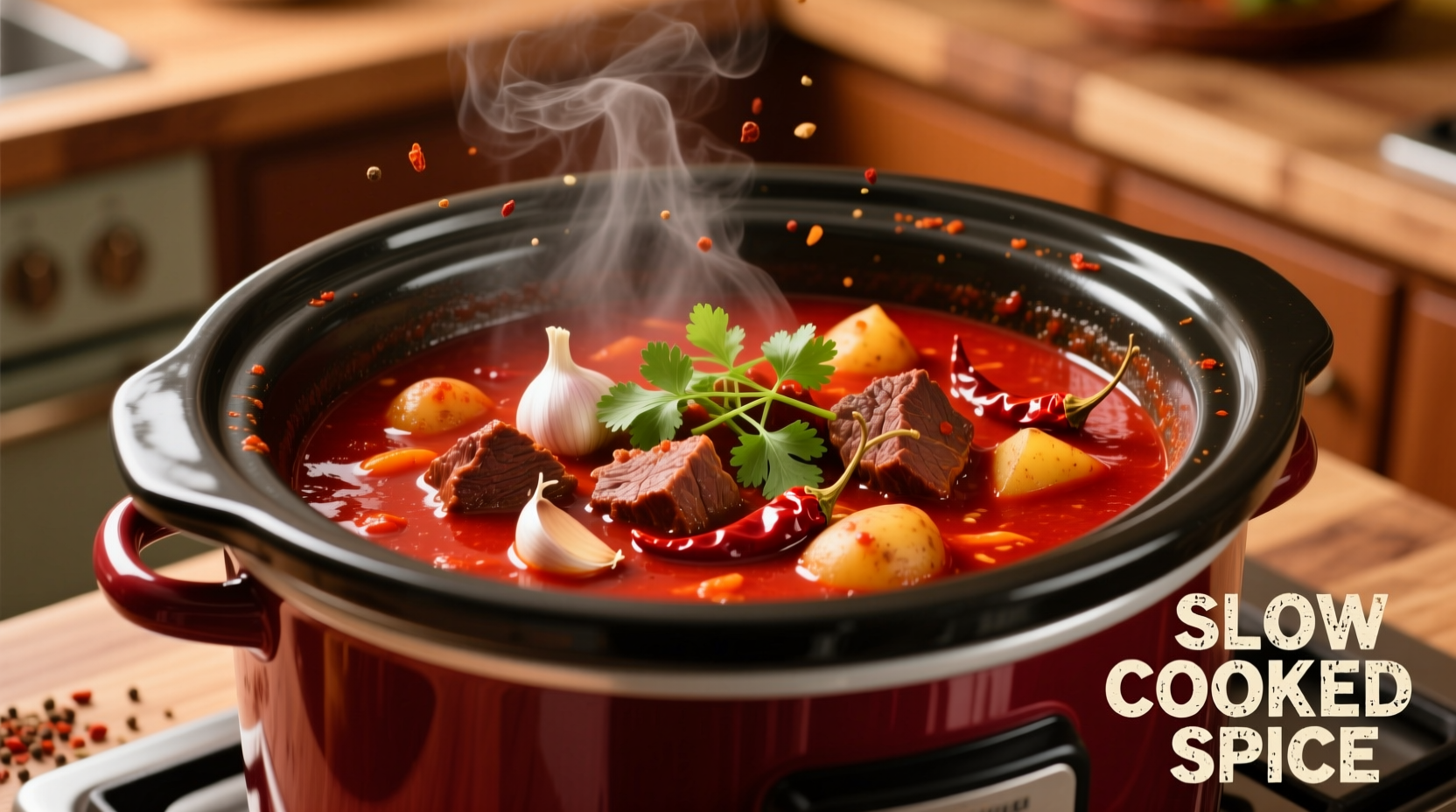Combine 2 lbs ground beef, 1 onion, 3 cloves garlic, 28 oz crushed tomatoes, 15 oz kidney beans, 15 oz pinto beans, 4 oz diced green chilies, 2 tbsp chili powder, 1 tbsp cumin, 1 tsp smoked paprika, 1 tsp oregano, 1/2 tsp cayenne (optional), and 1 cup beef broth in your slow cooker. Cook on low for 7-8 hours or high for 4-5 hours for perfect, hands-off chili every time.
The Ultimate Slow Cooker Chili Guide
Imagine coming home to the rich, complex aroma of simmering chili after a long day—no last-minute cooking stress, just deep, layered flavors developed through hours of gentle cooking. Slow cooker chili transforms simple ingredients into a hearty, satisfying meal with minimal effort. As someone who's studied chili varieties across Latin America for over a decade, I've perfected this approach to capture authentic flavors while maximizing convenience.
Why Slow Cooker Chili Works Best
Slow cooking allows flavors to meld gradually, creating depth impossible with quick stovetop methods. The gentle, consistent heat breaks down connective tissues in meat while preserving bean integrity. According to USDA food safety guidelines, maintaining temperatures above 140°F throughout cooking prevents bacterial growth while developing complex flavor compounds.
Essential Equipment Checklist
- 6-quart or larger slow cooker (essential for proper heat distribution)
- Cast-iron skillet (for proper meat browning)
- Wooden spoon (gentle on slow cooker surfaces)
- Measuring cups and spoons (precision matters for spice balance)
- Slotted spoon (for fat removal)
Ingredient Selection: Quality Makes the Difference
Authentic chili starts with quality ingredients. While traditional Mexican chili con carne contains no beans, most American versions include them—choose based on your preference. For authentic depth, select fire-roasted tomatoes and dried chilies instead of pre-made chili powder.
| Chili Variety | Heat Level (SHU) | Flavor Profile | Best Use in Chili |
|---|---|---|---|
| Ancho (dried poblano) | 1,000-2,000 | Fruity, raisin-like, mild heat | Base flavor, 2-3 peppers per batch |
| Guajillo | 2,500-5,000 | Berry-like, tangy, moderate heat | Complexity, 3-4 peppers per batch |
| Chipotle (smoked jalapeño) | 2,500-8,000 | Smoky, earthy, medium heat | Smokiness, 1-2 peppers per batch |
| Arbol | 15,000-30,000 | Sharp, nutty, intense heat | Heat boost, 1-2 peppers per batch |
Source: Texas A&M AgriLife Extension Service, "Chili Pepper Varieties and Uses," 2023
Step-by-Step Preparation Process
Prep Work (20 Minutes)
- Brown the meat: In a cast-iron skillet over medium-high heat, brown 2 lbs ground beef (80% lean) with 1 diced onion until no pink remains. Drain excess fat.
- Toast spices: Add 3 minced garlic cloves, 2 tbsp chili powder, 1 tbsp cumin, 1 tsp smoked paprika, and 1 tsp dried oregano. Cook 1 minute until fragrant.
- Prepare dried chilies (optional): Remove stems and seeds from 2-3 dried ancho peppers. Toast in dry skillet 30 seconds per side, then soak in hot water for 15 minutes before blending into paste.
- Combine ingredients: Transfer meat mixture to slow cooker. Add 28 oz crushed tomatoes, 15 oz kidney beans (drained), 15 oz pinto beans (drained), 4 oz diced green chilies, and 1 cup beef broth.
Cooking Process (Hands-Off Time)
Secure the lid and set your slow cooker to the appropriate setting:
- Low setting: 7-8 hours for maximum flavor development
- High setting: 4-5 hours for quicker preparation
According to USDA food safety guidelines, ensure your slow cooker maintains temperatures above 140°F throughout cooking. Most modern slow cookers reach this temperature within 2 hours on low setting, but older models may require preheating the cooker with hot broth.
Troubleshooting Common Issues
- Too watery? Remove lid during last hour of cooking or mix 1 tbsp cornstarch with 2 tbsp cold water and stir in during final 30 minutes.
- Not flavorful enough? Stir in 1 tbsp tomato paste and additional 1 tsp cumin during last hour.
- Beans too firm? Add 1/2 cup additional broth and continue cooking 1-2 hours.
- Too spicy? Stir in 1/4 cup sour cream or 2 tbsp honey to balance heat.
Flavor Variations to Try
Once you've mastered the basic technique, experiment with these authentic variations:
- Texas-Style: Omit beans and tomatoes, use only beef, onions, garlic, and dried chilies
- White Chicken Chili: Substitute chicken breast, white beans, green chilies, and cumin
- Vegan Option: Use plant-based meat substitute, vegetable broth, and extra beans
- Smoky Chipotle: Add 2-3 chipotle peppers in adobo sauce for deep smokiness
Serving and Storage Tips
For best results, let chili rest 15-20 minutes after cooking before serving. This allows flavors to settle and texture to improve. Top with fresh cilantro, diced onion, sour cream, or shredded cheese.
Storage: Cool completely within 2 hours of cooking. Store in airtight containers:
- Refrigerator: Up to 4 days
- Freezer: Up to 6 months (thaw overnight in refrigerator)
Reheating: Warm on stove over medium-low heat, stirring occasionally. Add broth if too thick.

Food Safety Considerations
Proper food handling ensures your slow cooker chili remains safe to eat:
- Never place frozen meat directly in slow cooker—thaw first
- Keep ingredients refrigerated until ready to use
- Discard chili left at room temperature longer than 2 hours
- Reheat to internal temperature of 165°F before serving leftovers
According to the USDA Food Safety and Inspection Service, slow cookers must maintain temperatures above 140°F to prevent bacterial growth. If your slow cooker takes longer than 2 hours to reach this temperature, consider replacing it or preheating ingredients with hot broth.











 浙公网安备
33010002000092号
浙公网安备
33010002000092号 浙B2-20120091-4
浙B2-20120091-4